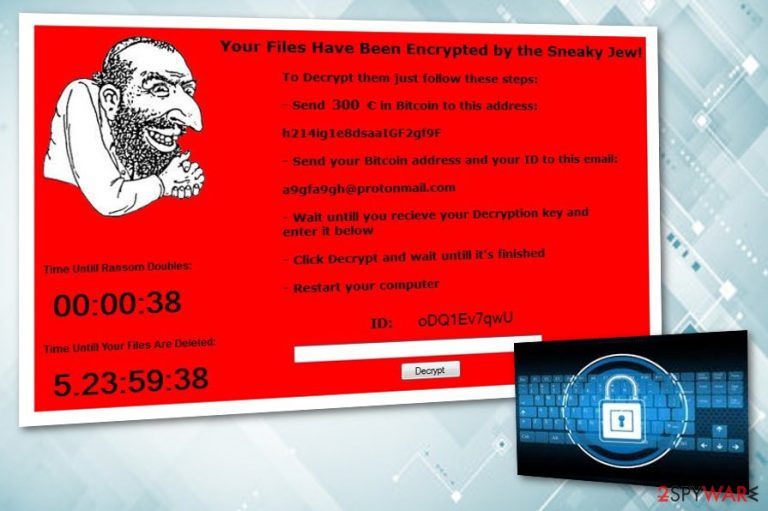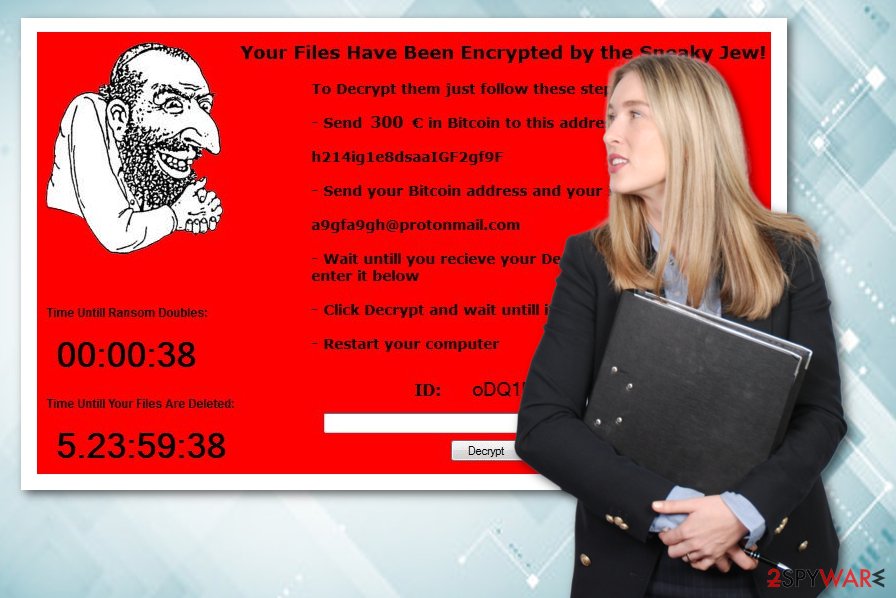Jewsomware ransomware (Free Guide) - Bonus: Decryption Steps
Jewsomware virus Removal Guide
What is Jewsomware ransomware?
Jewsomware – ransomware demands 300€ worth of ransom for encrypted file release

Jewsomware is a severe malware infection that uses an AES cipher to lock up relevant data. Personal files are encrypted by adding the .jewsomware extension. After such activity, Jewsomware virus displays a message which explains victims about the file encryption and demands a particular ransom. Cybercriminals urge victims to contact them by a9gfa9gh@protonmail.com email address and pay $300 in Bitcoin to get the decryption tool. Crooks also warn that in case the payment is not transferred within seven days, the size of ransom will double.
| Name | Jewsomware |
|---|---|
| Type | Ransomware |
| Danger level | High. Corrupts many files and turns them unusable |
| a9gfa9gh@protonmail.com | |
| Symptoms | Files with the .jewsomware extension show up, a ransom note is displayed |
| Spreading source | Spam messages |
| Deletion | Use FortectIntego |
Such ransomware infection is very similar to other viruses:
- Omerta;
- CryptoLocker;
- RedEye;
- zzz12;
- etc.
All of these viruses act the same (lock up data and demand ransom for it), just the size of payment might differ from time to time. Usually, money needs to be transferred using Bitcoin. Why so? The use of digital currency provides hackers anonymity which is vital for their illegal acts.
However, we do not recommend paying the ransom as cyber crooks are very likely to scam users after the payment is processed. Avoid contacting hackers by their given email address and remove Jewsomware virus from your computer system as soon as you detect it. For that, you should use professional anti-malware software. We advice downloading and installing FortectIntego or any other trustworthy anti-malware program.
Nevertheless, in some situations, ransomware might clean a path for other malware forms like Trojan horses[1] to enter the system very easily. It is not a common occurrence but still might happen. To avoid such risk perform the Jewsomware removal. Make sure that the cyber threat is gone for good.
It is advisable to store essential data on remote servers like cloud[2] or external devices – USB drive, external HDD, etc. However, if you did not manage back-up your files before ransomware struck, you can try using professional third-party software for your corrupted files. Be sure to keep your data fully secured next time. If it remains safe on a remote server, nobody can damage your data.

Spam messages can result in a ransomware attack
According to NoVirus.uk specialists[3], ransomware has a common spreading source – spam emails. You might have noticed emails falling to the Trash section (although some phishing emails manage to slip through into the Inbox as well). This is where you might find a ransomware payload. Such emails might look legitimate, but in reality, include a malicious link or a contaminated attachment. Be aware of such messages – if you are not expecting anything important, eliminate all spam emails you get.
A big piece of advice would be to download and install an antivirus program if you do not have one on your computer yet. If you do, make sure it is always kept up to date as it is required if you want it to work properly. The antivirus will scan the system and look out for various computer infections and safety risks.
Terminate Jewsomware ransomware
To remove Jewsomware virus, you need to install a trustworthy application. We recommend downloading anti-malware such as FortectIntego or Malwarebytes. It will provide instructions and help you to deal with the ransomware infection. Perform the elimination as soon as you spot files with the .jewsomware extension to avoid other possible damaging consequences.
After you carry out Jewsomware removal, notice that there is one more action you need to do. Work on some system backups. This will ensure that, in case you get attacked by ransomware again, you can recover your data with no problems.
Getting rid of Jewsomware virus. Follow these steps
Manual removal using Safe Mode
Use Safe Mode with Networking:
Important! →
Manual removal guide might be too complicated for regular computer users. It requires advanced IT knowledge to be performed correctly (if vital system files are removed or damaged, it might result in full Windows compromise), and it also might take hours to complete. Therefore, we highly advise using the automatic method provided above instead.
Step 1. Access Safe Mode with Networking
Manual malware removal should be best performed in the Safe Mode environment.
Windows 7 / Vista / XP
- Click Start > Shutdown > Restart > OK.
- When your computer becomes active, start pressing F8 button (if that does not work, try F2, F12, Del, etc. – it all depends on your motherboard model) multiple times until you see the Advanced Boot Options window.
- Select Safe Mode with Networking from the list.

Windows 10 / Windows 8
- Right-click on Start button and select Settings.

- Scroll down to pick Update & Security.

- On the left side of the window, pick Recovery.
- Now scroll down to find Advanced Startup section.
- Click Restart now.

- Select Troubleshoot.

- Go to Advanced options.

- Select Startup Settings.

- Press Restart.
- Now press 5 or click 5) Enable Safe Mode with Networking.

Step 2. Shut down suspicious processes
Windows Task Manager is a useful tool that shows all the processes running in the background. If malware is running a process, you need to shut it down:
- Press Ctrl + Shift + Esc on your keyboard to open Windows Task Manager.
- Click on More details.

- Scroll down to Background processes section, and look for anything suspicious.
- Right-click and select Open file location.

- Go back to the process, right-click and pick End Task.

- Delete the contents of the malicious folder.
Step 3. Check program Startup
- Press Ctrl + Shift + Esc on your keyboard to open Windows Task Manager.
- Go to Startup tab.
- Right-click on the suspicious program and pick Disable.

Step 4. Delete virus files
Malware-related files can be found in various places within your computer. Here are instructions that could help you find them:
- Type in Disk Cleanup in Windows search and press Enter.

- Select the drive you want to clean (C: is your main drive by default and is likely to be the one that has malicious files in).
- Scroll through the Files to delete list and select the following:
Temporary Internet Files
Downloads
Recycle Bin
Temporary files - Pick Clean up system files.

- You can also look for other malicious files hidden in the following folders (type these entries in Windows Search and press Enter):
%AppData%
%LocalAppData%
%ProgramData%
%WinDir%
After you are finished, reboot the PC in normal mode.
Remove Jewsomware using System Restore
Disable the virus by turning on the System Restore mode:
-
Step 1: Reboot your computer to Safe Mode with Command Prompt
Windows 7 / Vista / XP- Click Start → Shutdown → Restart → OK.
- When your computer becomes active, start pressing F8 multiple times until you see the Advanced Boot Options window.
-
Select Command Prompt from the list

Windows 10 / Windows 8- Press the Power button at the Windows login screen. Now press and hold Shift, which is on your keyboard, and click Restart..
- Now select Troubleshoot → Advanced options → Startup Settings and finally press Restart.
-
Once your computer becomes active, select Enable Safe Mode with Command Prompt in Startup Settings window.

-
Step 2: Restore your system files and settings
-
Once the Command Prompt window shows up, enter cd restore and click Enter.

-
Now type rstrui.exe and press Enter again..

-
When a new window shows up, click Next and select your restore point that is prior the infiltration of Jewsomware. After doing that, click Next.


-
Now click Yes to start system restore.

-
Once the Command Prompt window shows up, enter cd restore and click Enter.
Bonus: Recover your data
Guide which is presented above is supposed to help you remove Jewsomware from your computer. To recover your encrypted files, we recommend using a detailed guide prepared by 2-spyware.com security experts.If you want to recover files encrypted with the .jewsomware extension, look through the following decryption methods.
If your files are encrypted by Jewsomware, you can use several methods to restore them:
Use Data Recovery Pro:
This tool will let you restore various important data.
- Download Data Recovery Pro;
- Follow the steps of Data Recovery Setup and install the program on your computer;
- Launch it and scan your computer for files encrypted by Jewsomware ransomware;
- Restore them.
Try Windows Previous Versions feature:
Try using this tool to recover files. It will work only if you enabled the System Restore function before the cyber attack.
- Find an encrypted file you need to restore and right-click on it;
- Select “Properties” and go to “Previous versions” tab;
- Here, check each of available copies of the file in “Folder versions”. You should select the version you want to recover and click “Restore”.
Use Shadow Explorer:
If the ransomware did not eliminate Shadow Copies of your files, try using this method to recover some individual files:
- Download Shadow Explorer (http://shadowexplorer.com/);
- Follow a Shadow Explorer Setup Wizard and install this application on your computer;
- Launch the program and go through the drop down menu on the top left corner to select the disk of your encrypted data. Check what folders are there;
- Right-click on the folder you want to restore and select “Export”. You can also select where you want it to be stored.
There is no official Jewsomware decryptor.
Finally, you should always think about the protection of crypto-ransomwares. In order to protect your computer from Jewsomware and other ransomwares, use a reputable anti-spyware, such as FortectIntego, SpyHunter 5Combo Cleaner or Malwarebytes
How to prevent from getting ransomware
Choose a proper web browser and improve your safety with a VPN tool
Online spying has got momentum in recent years and people are getting more and more interested in how to protect their privacy online. One of the basic means to add a layer of security – choose the most private and secure web browser. Although web browsers can't grant full privacy protection and security, some of them are much better at sandboxing, HTTPS upgrading, active content blocking, tracking blocking, phishing protection, and similar privacy-oriented features. However, if you want true anonymity, we suggest you employ a powerful Private Internet Access VPN – it can encrypt all the traffic that comes and goes out of your computer, preventing tracking completely.
Lost your files? Use data recovery software
While some files located on any computer are replaceable or useless, others can be extremely valuable. Family photos, work documents, school projects – these are types of files that we don't want to lose. Unfortunately, there are many ways how unexpected data loss can occur: power cuts, Blue Screen of Death errors, hardware failures, crypto-malware attack, or even accidental deletion.
To ensure that all the files remain intact, you should prepare regular data backups. You can choose cloud-based or physical copies you could restore from later in case of a disaster. If your backups were lost as well or you never bothered to prepare any, Data Recovery Pro can be your only hope to retrieve your invaluable files.
- ^ Trojan horse (computing). Wikipedia. The free encyclopedia.
- ^ iCloud: What is iCloud?. Apple Support. For your services.
- ^ NoVirus. IT security solutions.







